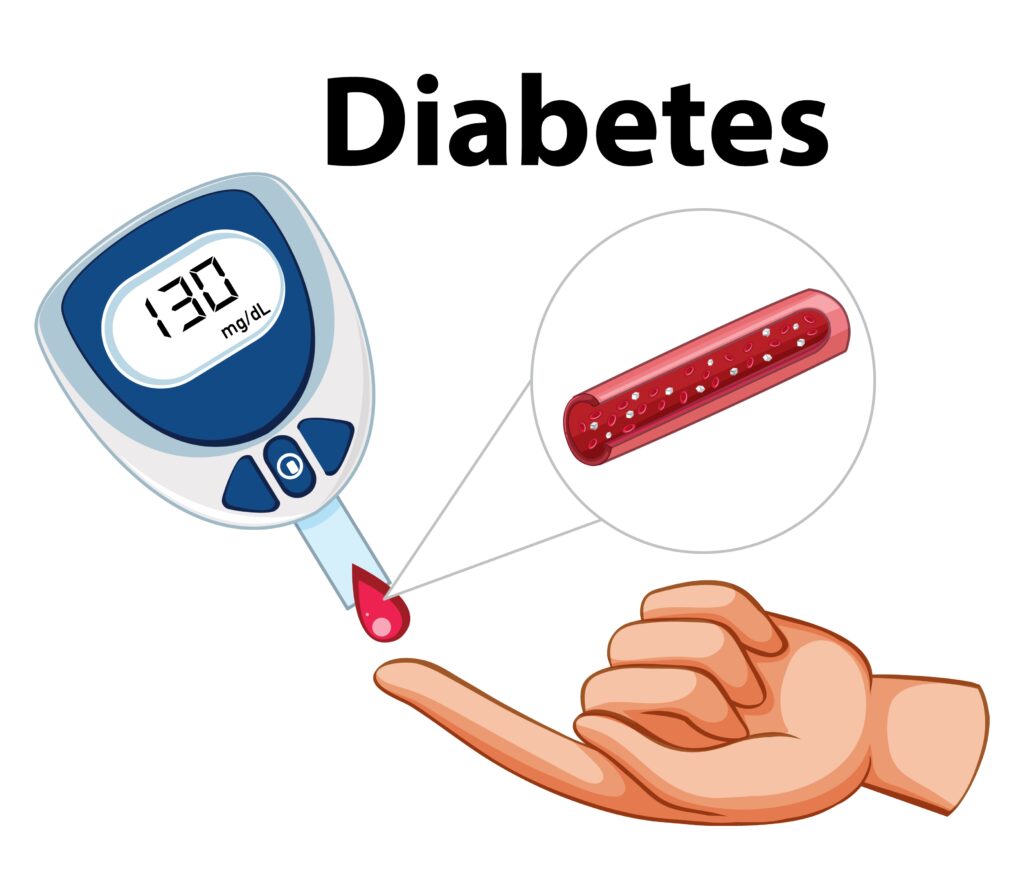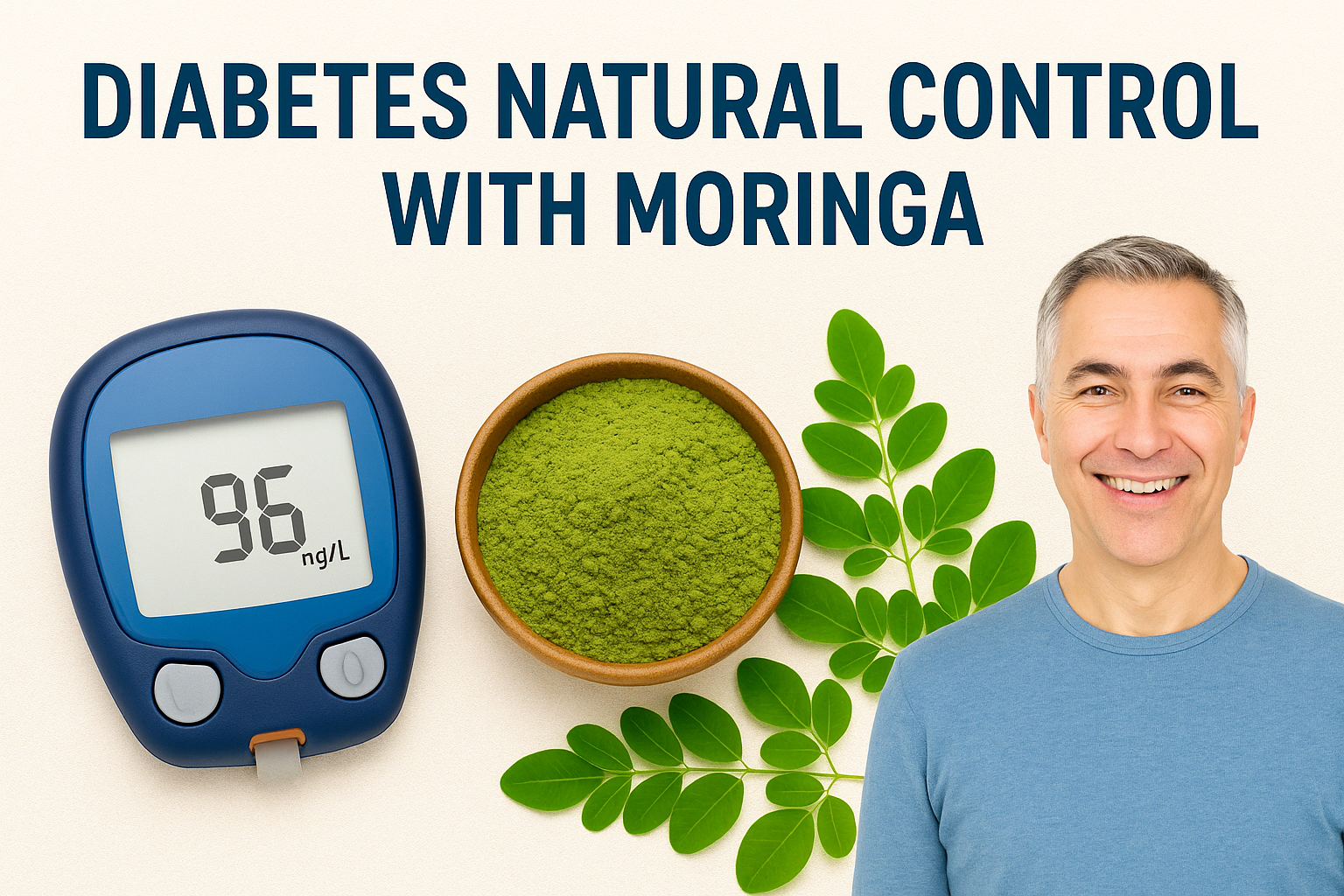Introduction
In today’s fast-paced world, the number of people living with diabetes is rising — and not just among the elderly. Even teenagers and young adults are being diagnosed with type 2 diabetes, mostly due to sedentary lifestyles, poor diets, and constant stress. While modern medicine plays a crucial role in treatment, more people are exploring diabetes natural control with Moringa and other herbal remedies. Moringa Oleifera, often called the “Miracle Tree,” is gaining popularity for its ability to regulate blood sugar levels, reduce inflammation, and improve metabolism naturally. But how effective is it really? Let’s explore the science and practical ways to use Moringa for diabetes control in the modern age.

What is Diabetes?
Diabetes mellitus is a chronic metabolic condition in which the body is either unable to produce insulin or cannot use it effectively. Insulin is the hormone responsible for controlling blood sugar levels. Without proper insulin function, blood sugar (glucose) stays elevated, damaging organs like the heart, kidneys, nerves, and eyes over time.
Understanding Diabetes by Body Function: Type 1, Type 2 and Gestational
Type 1 Diabetes – Autoimmune Attack on the Pancreas
In the human body, a small organ called the pancreas (located behind the stomach) plays a key role in blood sugar control. Inside the pancreas are beta cells in a region called the islets of Langerhans. Their main job is to produce insulin, a hormone that allows glucose (sugar) to enter body cells and produce energy.
In Type 1 diabetes, the immune system mistakenly attacks and destroys these insulin-producing beta cells. As a result:
- The pancreas produces little or no insulin
- Sugar remains in the bloodstream instead of entering cells
- The body cannot produce energy efficiently
This form of diabetes usually starts in childhood or adolescence and requires lifelong insulin therapy because the body loses its ability to make insulin.
Key Physiology: Complete destruction of beta cells leads to zero insulin production. This causes lifelong dependence on insulin from external sources.
Type 2 Diabetes – Insulin Resistance or Insulin Deficiency
Type 2 diabetes is the most common form of diabetes in adults and increasingly seen in younger individuals. It occurs when:
- The pancreas still produces insulin, but
- The body’s cells do not respond properly to it (a condition known as insulin resistance)
- Over time, the pancreas becomes overworked and may start producing less insulin
As a result, glucose remains in the bloodstream, and the body is unable to convert it into energy effectively.
This condition is strongly linked with:
- Poor diet and high sugar intake
- Sedentary lifestyle
- Obesity
- Stress and hormonal imbalance
Type 2 diabetes can often be managed or reversed with proper diet, physical activity, and supportive natural remedies like Moringa.
Key Physiology: Body cells become resistant to insulin. The pancreas compensates by producing more insulin, but eventually insulin production decreases.
Why Are Young People Getting Diabetes Today?
In the past, diabetes—especially Type 2—was commonly seen in people above 40. But now, more teenagers and people in their 20s and even children are being diagnosed. This shift is largely due to rapid lifestyle changes in the digital era. Let’s break it down:
1. Junk Food and Processed Diets
Young people today consume more fast food, sugary snacks, and processed meals than ever before. These foods are high in sugar, unhealthy fats, and calories, which spike blood sugar levels and lead to weight gain and insulin resistance.
2. Lack of Physical Activity
Many youngsters spend hours sitting with phones, computers, or gaming consoles, and hardly engage in physical activities. This sedentary lifestyle slows metabolism and reduces insulin sensitivity, increasing the risk of diabetes.
3. Obesity Epidemic
Being overweight or obese is one of the biggest risk factors for Type 2 diabetes. According to the World Health Organization, the rate of obesity in children and adolescents has tripled in the last 40 years, especially in urban areas.
4. Stress and Poor Sleep
School pressure, career anxiety, social media stress, and late-night screen use cause mental stress and disturbed sleep. Both increase cortisol levels (a stress hormone), which can raise blood sugar and insulin resistance.
5. Genetics and Family History
Children of diabetic parents have a higher chance of developing diabetes, especially when poor lifestyle habits are added to the mix.
6. Overuse of Sugary Beverages
Soft drinks, energy drinks, and even “fruit juices” loaded with sugar are consumed daily. These cause frequent insulin spikes, eventually tiring out the body’s ability to manage sugar.
Can Diabetes Be Controlled with Natural Remedies Like Moringa?
Yes, especially in the early or prediabetic stages, natural remedies like Moringa Oleifera can play a powerful supportive role in managing blood sugar levels — when combined with healthy lifestyle changes.
Moringa is rich in plant compounds like chlorogenic acid, quercetin, and isothiocyanates, which help regulate glucose in several ways:
- ✅ Slows carbohydrate digestion to avoid sudden sugar spikes after meals
- ✅ Improves insulin sensitivity so your body uses insulin more efficiently
- ✅ Supports pancreatic health, helping the body naturally produce insulin
- ✅ Reduces inflammation and oxidative stress, which are often high in diabetics
Clinical studies have shown that daily intake of moringa powder or capsules can lower fasting blood sugar levels by up to 30%, especially in early stages of diabetes.
However, it’s important to note:
Moringa should not replace prescribed medicines for those with advanced or insulin-dependent diabetes, but it can be used as a safe complementary therapy under medical supervision.
Natural remedies work gradually and are most effective when paired with exercise, a balanced diet, and routine checkups.
Moringa: A Natural Ally Against Diabetes
Moringa Oleifera, also known as the Drumstick Tree or Miracle Tree, is widely praised in both Ayurvedic and modern medicine for its anti-diabetic and antioxidant properties. From leaves to seeds, every part of this plant has therapeutic potential.
Nutritional & Medicinal Value of Moringa
Moringa is packed with vital nutrients that benefit diabetic patients:
- Flavonoids (Quercetin, Kaempferol): Antioxidant & anti-inflammatory
- Isothiocyanates: Regulate blood sugar levels
- Chlorogenic acid: Delays sugar absorption in the gut
- Vitamins: A, C, E (immune support, healing)
- Minerals: Magnesium, Calcium, Iron, Zinc
- Proteins & Amino Acids: Contains all 9 essential amino acids
How Moringa Works Against Diabetes
Unlike single-target medicines, Moringa works through multiple biological pathways. Here’s how:
1. Delays Sugar Absorption
Its fiber and chlorogenic acid slow down carbohydrate digestion and reduce sugar spikes after meals.
2. Stimulates Insulin Secretion
Bioactive compounds stimulate the β-cells in the pancreas, improving insulin production.
3. Improves Insulin Sensitivity
Moringa makes cells more responsive to insulin, helping glucose enter the cells instead of remaining in the blood.
4. Reduces Inflammation and Oxidative Stress
Diabetics often suffer from chronic inflammation. Moringa contains flavonoids that act like natural anti-inflammatories, reducing TNF-α and IL-6.
5. Prevents Long-Term Complications
By reducing sugar, inflammation, and bad cholesterol (LDL), moringa helps protect the heart, kidneys, liver, and eyes from diabetes-related damage.
✅ A 2021 NCBI study found that Moringa leaf powder can reduce fasting blood sugar by 13–30% in people with Type 2 Diabetes.
Key Benefits of Moringa for Diabetics
- Helps lower fasting and post-meal blood sugar
- Boosts energy by correcting micronutrient deficiencies
- Improves digestion and gut health
- Aids in cholesterol reduction
- Supports weight loss due to high fiber
Dosage and How to Use
| Form | Dosage | How to Use |
|---|---|---|
| Leaf Powder | 5–10 grams/day | Mix with warm water, smoothies, or sprinkle on food |
| Capsules | 500 mg twice/day | With meals |
| Fresh Leaves | 10–20 leaves/day | Add to sabzi, chutney, or soup |
| Herbal Tea | 1–2 cups/day | Brew dried moringa leaves in hot water |
Safety & Precautions
- Monitor sugar regularly—may enhance effects of diabetes medicines
- Avoid high doses (can cause stomach upset or low sugar)
- Not recommended in pregnancy without doctor’s advice
Common FAQs: Diabetes, Moringa & Modern Health Concerns
Q1. Can COVID vaccines cause diabetes?
No. There is no scientific evidence that COVID-19 vaccines directly cause diabetes. In rare cases, people may notice a temporary rise in blood sugar, but this usually stabilizes quickly. For people with diabetes, vaccination offers essential protection against severe COVID complications.
Q2. Is it safe to take moringa every day for diabetes?
Yes, moringa is generally safe in moderate doses. You can take 1 teaspoon of moringa powder or 1–2 capsules per day. However, since moringa can naturally lower blood sugar, people on anti-diabetic medication should consult a healthcare professional to avoid hypoglycemia.
Q3. Why are more young people getting type 2 diabetes now?
Today’s youth are more exposed to ultra-processed foods, screen time, stress, and poor sleep. These modern lifestyle factors disrupt insulin sensitivity and metabolism, making type 2 diabetes increasingly common among people in their 20s and even teens.
Q4. Is heart attack risk real after COVID vaccination in diabetics?
No direct link has been found between COVID vaccines and heart attacks. In contrast, COVID infection itself increases the risk of heart inflammation, clots, and cardiac arrest, especially in individuals with uncontrolled diabetes. So vaccination is a safer preventive tool.
Trusted References (External Links)
🔗 NCBI – COVID Vaccine & Blood Sugar Study
🔗 IndiaTimes – ICMR Report on Sudden Deaths
🔗 Healthline – Moringa for Blood Sugar & Diabetes
Related Reading (Internal Links)
Also read: Top Herbal Remedies for Immunity.
Key Takeaway
Moringa is a powerful natural supplement that can support diabetes control and improve overall health.
Conclusion: Natural Control Is Possible in the Modern Age
In a world full of fast food, digital overload, and rising stress levels, diabetes is no longer an old age disease. It is now one of the fastest-growing lifestyle conditions — even in young adults. But there’s hope.
By understanding your body and making simple changes, you can take control. Adding natural herbs like moringa, following a balanced routine, and avoiding misinformation can reduce your dependence on lifelong medications.
Moringa is not a miracle cure, but a scientifically supported superfood that works best when combined with healthy daily habits.
With awareness, commitment, and nature’s support — you can prevent, manage, and control diabetes in this modern age


Awesome post